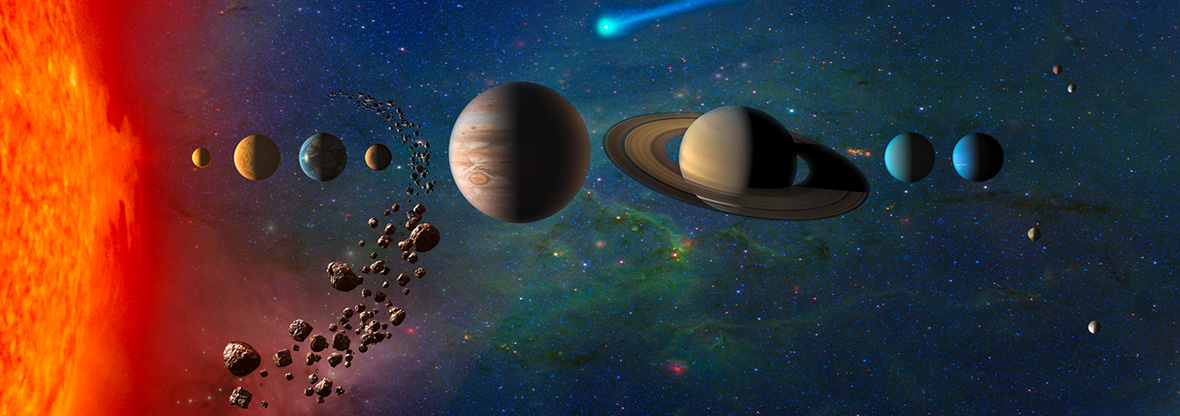Move like the Earth and the Moon
We don't often think of our planet this way, but it's like a spaceship moving through space. Our neighbour the Moon orbits the Earth, which affects how we see it in the sky. It's interesting to change your perspective and imagine and recreate those movements.
Objective
With your friends, create a model of the Earth, the Moon and the Sun in motion to see how they move in space.
You will need
- At least two people
- A flashlight to represent the Sun (optional)
- A space large enough to move around (large room, outdoors, etc.)
How it works
If you want, you can start by making necklaces to show who is playing the Earth, the Moon and the Sun. Use posterboard, scissors, a hole punch, coloured pencils and string to make necklaces like those in the picture. Note: younger participants will need adult supervision and assistance for this part.


DIY necklaces representing the Earth, the Moon and the Sun. (Credit: Canadian Space Agency [CSA])
- Create your model
- Decide each person's role: Earth, Moon, Sun or spectator, and distribute the necklaces if you want to.
- Before you keep reading, think about the movements each person will have to make to simulate movements in space. How does the Moon move? How does the Earth move? Does the Sun move too?
- For now, start with the Earth at the centre and the Moon that will orbit. The Sun will be included a little later in the activity.
- Imitate the movement of the Moon around the Earth (revolution)
- Simulate the revolution of the Moon around the Earth. The Moon-person will move in circles around the Earth-person.
- Do you know how long it takes for the Moon to orbit the Earth? It takes just over 27 days (27.3 days).
- Imitate the rotation of the Earth and the Moon
- You may know that the Earth spins too. This is what we call rotation. Add this movement to your model.
- How long does it take for the Earth to make a full spin? It takes one day (24 hours). Does the Moon spin too? It does, but much more slowly: it completes a spin in exactly 27.3 days. Did you notice that the Moon takes the same amount of time to complete a spin as it does to orbit the Earth?
- While the Moon-person slowly makes a circle around the Earth-person, the Earth-person should spin about 27 times. Don't get dizzy! You don't actually have to match these times.
- Since it takes about 27 days for the Moon to complete a spin, the Moon-person should always face the Earth-person when moving around them. If your team has spectators, ask them if, from their perspective, the Moon seems to be spinning. When the Moon orbits the Earth, the spectators should be able to see all sides of the Moon (front, back, both sides). From Earth, we don't see the Moon spinning, because we always see the same side of it.
The movements of the Earth and the Moon. Created using WorldWideTelescope. (Credit: CSA)
- Reproduce the phases of the Moon
- To take your model to the next level, add the Sun. If you have a flashlight, the Sun-person can use it. If possible, turn down the lights in the room.
- Half of the Earth and the Moon is always lit by the Sun. You can ask each person in your model to say what they see when they move: when do they see the Sun-person? For the Sun-person: which part of each other person are they lighting (front, back, side)?
- To represent the phases of the Moon, think about what the Earth-person sees when they look at the Moon-person at each point of the Moon's revolution. The Moon-person is always half lit (the part facing the Sun), but the Earth-person doesn't always see that half.
- Try to reproduce the full moon. Start again with the new moon, and then move through the other phases of the Moon.

Phases of the Moon. From left to right: waxing crescent, first quarter, waxing gibbous, full moon, waning gibbous, third quarter, waning crescent. (Credits: CSA, NASA's Scientific Visualization Studio)
- Reproduce eclipses
- You may have noticed that at certain points, the Moon-person or the Earth-person is blocking the light of the Sun. Because your model isn't to scale, eclipses are created at each revolution of the Moon.
- A lunar eclipse happens when the Moon-person moves into the shadow of the Earth-person. Create this movement in your model.
- A solar eclipse happens when the Moon-person makes a shadow on the Earth-person. Create this movement in your model.
- In reality, eclipses are much more rare, because the shadows are much smaller than those in your model.
Did you know?
There are other movements that you didn't imitate in this activity:
- The Earth revolves around the Sun. It takes 365 days (one year) to complete one revolution. The Moon follows the Earth throughout its trip around the Sun.
- The Sun, as well as the entire solar system, is also moving through the galaxy, the Milky Way. It takes nearly 200 million years to make the trip once!
Curriculum focus areas
Key concepts related to the science curriculum
- Night sky
- Apparent movement of celestial objects
- Earth-Moon-Sun system
- Orbits of the Earth and the Moon
- Revolution and rotation of the Earth and the Moon
- Phases of the Moon
- Lunar and solar eclipses
- Properties of light
- Straight line propagation
- Shadow and light
